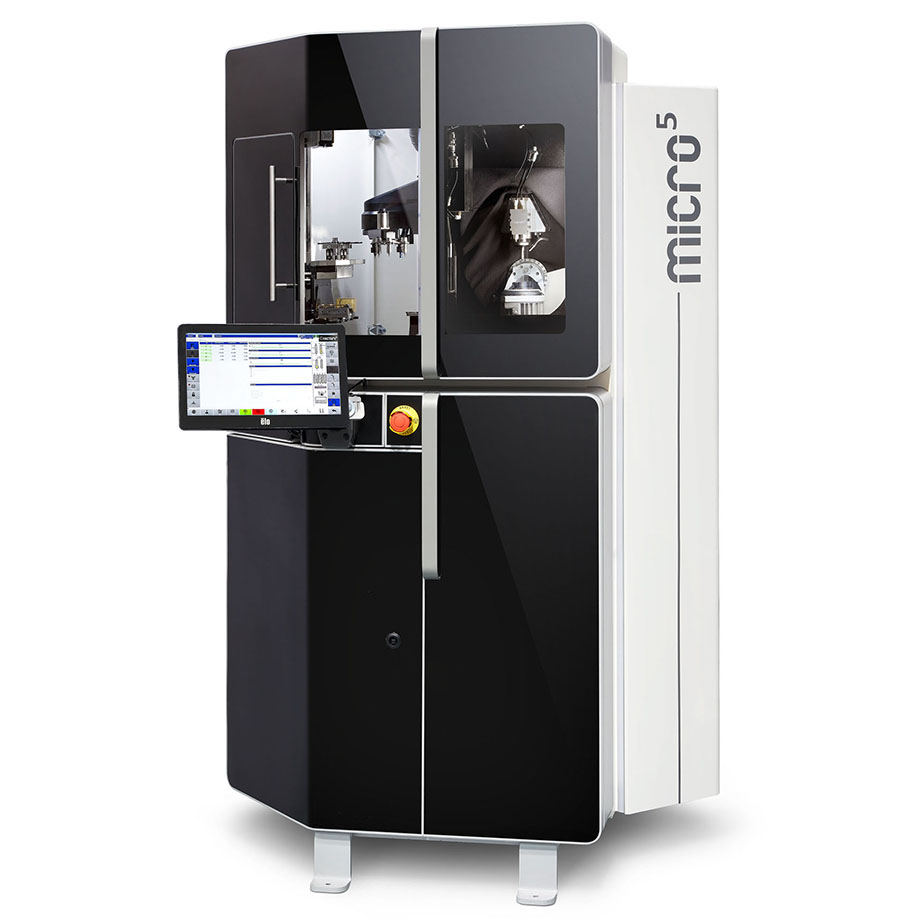The number in the name is a big part of the story about the Micro5 machining center.
Sold by Germany-headquartered Chiron Group, the refrigerator-size Micro5 is designed to machine small and delicate parts for industries like medical, jewelry, watchmaking and electronics. The five-axis machine can handle workpiece sizes up to 50 mm × 50 mm × 50 mm.
More machine statistics featuring the number five include 500 W energy consumption, which is much lower than that of conventional machines, Chiron reports. There’s also 0.5 µm repeatability, along with 2 µm target accuracy, and a noise level under 50 db, making the Micro5 quieter than a dishwasher, the company notes.
But according to Chiron, the main descriptors with the number deal with the weight of the machine — five times less than conventional machines — and the 5-1 ratio of key machine dimensions to those of workpieces. This unique ratio has numerous benefits for the machining process, said Simon Knecht, vice president of sales and marketing at Chiron America Inc. in Charlotte, North Carolina.

He explained that dimensions covered by the 5-1 ratio include those in the area that encompasses the moving components of the machine.
“For little parts,” Knecht said, “that small work envelope enables very high accuracy in a fast, dynamic machine process.”
Accuracy is improved by the stiffness and thermal stability of the machine, both of which he attributes to the dimensions of its kinematic region and the design of components in that area. Thermal growth of the metal components is limited by their small size, he noted, while stiffness is enhanced by relatively small travel distances and the lack of problematic overhangs.
“Certain machines will lose dynamic stiffness in the work zone because they have an overhang, where a mass is hanging or pulling on some guide way,” Knecht said. “So the focus was designing (the machine) so it doesn’t lose rigidity anywhere in the work area of the
kinematics.”
As for the low energy consumption touted by Chiron, he said that too is mainly a function of size. The weight of the small kinematic system in the machine is only 35 kg, he noted, which is much easier for a motor to move than a larger system weighing 500 kg. Also lowering energy consumption are lightweight 3D-printed components, he added.
Made for high-speed machining, the Micro5 also features a high-performance milling spindle capable of speeds up to 60,000 rpm, which can significantly reduce machining time. Knecht said other benefits of HSM include less heat generation and longer tool life.
He added that suitable applications for the Micro5 are those that involve “light cuts” rather than heavy-duty machining. Light cutting of small workpieces minimizes chatter and produces good surface finishes, he noted.
Chiron reports that early users of the Micro5 wanted automatic loading and unloading to boost production capacity. So the company now offers the Feed5, a six-axis robot, to work in tandem with the machine. Compact like the Micro5, the Feed5 enables increased operational autonomy during longer production runs.
Although other systems are capable of machining the same types of parts as the Micro5, Knecht believes that what sets the machine apart is the combination of advantages it offers.
“Can you machine a watch on any other machine? Yes,” he said. “But can you machine a watch with the speed, accuracy and process stability of our machine? That's where it’s really unique.”
For more information from Chiron about the Micro5 machining center, view a video presentation at https://qr.ctemag.com/1m4h1
Contact Details
Related Glossary Terms
- chatter
chatter
Condition of vibration involving the machine, workpiece and cutting tool. Once this condition arises, it is often self-sustaining until the problem is corrected. Chatter can be identified when lines or grooves appear at regular intervals in the workpiece. These lines or grooves are caused by the teeth of the cutter as they vibrate in and out of the workpiece and their spacing depends on the frequency of vibration.
- dynamic stiffness
dynamic stiffness
Measure of a machining system’s ability to dampen vibration from a forced input. If the dynamic stiffness of a system is not sufficient to dampen vibration, chatter occurs. See static stiffness; stiffness.
- gang cutting ( milling)
gang cutting ( milling)
Machining with several cutters mounted on a single arbor, generally for simultaneous cutting.
- machining center
machining center
CNC machine tool capable of drilling, reaming, tapping, milling and boring. Normally comes with an automatic toolchanger. See automatic toolchanger.
- milling
milling
Machining operation in which metal or other material is removed by applying power to a rotating cutter. In vertical milling, the cutting tool is mounted vertically on the spindle. In horizontal milling, the cutting tool is mounted horizontally, either directly on the spindle or on an arbor. Horizontal milling is further broken down into conventional milling, where the cutter rotates opposite the direction of feed, or “up” into the workpiece; and climb milling, where the cutter rotates in the direction of feed, or “down” into the workpiece. Milling operations include plane or surface milling, endmilling, facemilling, angle milling, form milling and profiling.
- stiffness
stiffness
1. Ability of a material or part to resist elastic deflection. 2. The rate of stress with respect to strain; the greater the stress required to produce a given strain, the stiffer the material is said to be. See dynamic stiffness; static stiffness.
- work envelope
work envelope
Cube, sphere, cylinder or other physical space within which the cutting tool is capable of reaching.


